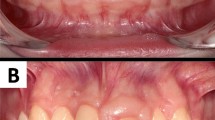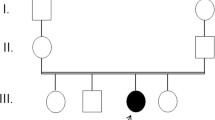Abstract
Non-syndromic hereditary gingival fibromatosis (HGF) is a rare condition, characterized by a progressive gingival hyperplasia that occurs as an isolated disease. Hitherto, only one insertion (g.126,142–126,143insC) in son-of-sevenless-1 (SOS1) gene has been associated with non-syndromic HGF in a Brazilian family. The aim of the present study was to determine if SOS1 is the causative gene of non-syndromic HGF in the Chinese population. Peripheral blood samples were collected from six affected and seven unaffected individuals from three Chinese families with history of non-syndromic HGF. Genomic DNA was extracted and SOS1 gene exons were sequenced. Neither g.126,142–126,143insC nor any other novel mutation was detected in SOS1 gene. Our results suggest that the SOS1 may not be the gene responsible for HGF in these three Chinese families and, therefore, it is possible that other genes are involved in the manifestation of HGF in these Chinese HGF families.


Similar content being viewed by others
References
Gorlin, R. J., Cohen, M. M., & Levin, L. S. (1990). Syndromes of the Head and Neck (3rd ed., pp. 847–858). New York: Oxford University Press.
Baptista, I. P. (2002). Hereditary gingival fibromatosis: A case report. Journal of Clinical Periodontology, 29(9), 814–871.
Majumder, P., et al. (2013). The autosomal recessive inheritance of hereditary gingival fibromatosis. Case Rep: Dent. 432864.
Fryns, J. P. (1996). Gingival fibromatosis and partial duplication of the short arm of chromosome 2 (dup(2)(p13– > p21)). Annales de Genetique, 39(1), 54–55.
Shashi, V., et al. (1999). Genetic heterogeneity of gingival fibromatosis on chromosome 2p. Journal of Medical Genetics, 36(9), 683–686.
Hart, T. C., et al. (1998). Genetic linkage of hereditary gingival fibromatosis to chromosome 2p21. American Journal of Human Genetics, 62(4), 876–883.
Hart, T. C., et al. (2002). A mutation in the SOS1 gene causes hereditary gingival fibromatosis type 1. American Journal of Human Genetics, 70(4), 943–954.
Ye, X., et al. (2005). A novel locus for autosomal dominant hereditary gingival fibromatosis, GINGF3, maps to chromosome 2p22.3-p23.3. Clinical Genetics, 68(3), 239–244.
Xiao, S., et al. (2001). A new locus for hereditary gingival fibromatosis (GINGF2) maps to 5q13-q22. Genomics, 74(2), 180–185.
Zhu, Y., et al. (2007). A novel locus for maternally inherited human gingival fibromatosis at chromosome 11p15. Human Genetics, 121(1), 113–123.
Xiao, S., et al. (2000). Refinement of the locus for autosomal dominant hereditary gingival fibromatosis (GINGF) to a 3.8-cM region on 2p21. Genomics, 68(3), 247–252.
Pierre, S., et al. (2011). Understanding SOS (Son of Sevenless). Biochemical Pharmacology, 82(9), 1049–1056.
Kather, J., Salgado, M. A. C., Salgado, U. F. L., Cortelli, J. R., & Pallos, D. (2008). Clinical and histomorphometric characteristics of three different families with hereditary gingival fibromatosis. Oral Surgery, Oral Medicine, Oral Pathology, Oral Radiology, and Endodontics, 105, 348–352.
Lee, E. J., et al. (2006). Characterization of fibroblasts with Son of Sevenless-1 mutation. Journal of Dental Research, 85(11), 1050–1055.
Roberts, A. E., et al. (2007). Germline gain-of-function mutations in SOS1 cause Noonan syndrome. Nature Genetics, 39(1), 70–74.
Häkkinen, L., & Csiszar, A. (2007). Hereditary gingival fibromatosis: Characteristics and novel putative pathogenic mechanisms. Journal of Dental Research, 86(1), 25–34.
Burns, M. C., et al. (2014). Approach for targeting Ras with small molecules that activate SOS-mediated nucleotide exchange. Proceedings of the National Academy of Sciences of the United States of America, 111(9), 3401–3406.
Acknowledgments
This work was supported by the National Natural Science Foundation of China (Grant Number 83172891) and a Grant for high-level Talents of Beijing Health System (Grant Number 2013-3-036).
Author information
Authors and Affiliations
Corresponding authors
Rights and permissions
About this article
Cite this article
Ma, Y., Sun, Z., Hu, Y. et al. Non-Syndromic Hereditary Gingival Fibromatosis in Three Chinese Families is Not Due to SOS1 Gene Mutations. Cell Biochem Biophys 70, 1869–1873 (2014). https://doi.org/10.1007/s12013-014-0144-9
Published:
Issue Date:
DOI: https://doi.org/10.1007/s12013-014-0144-9




